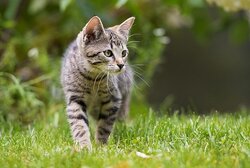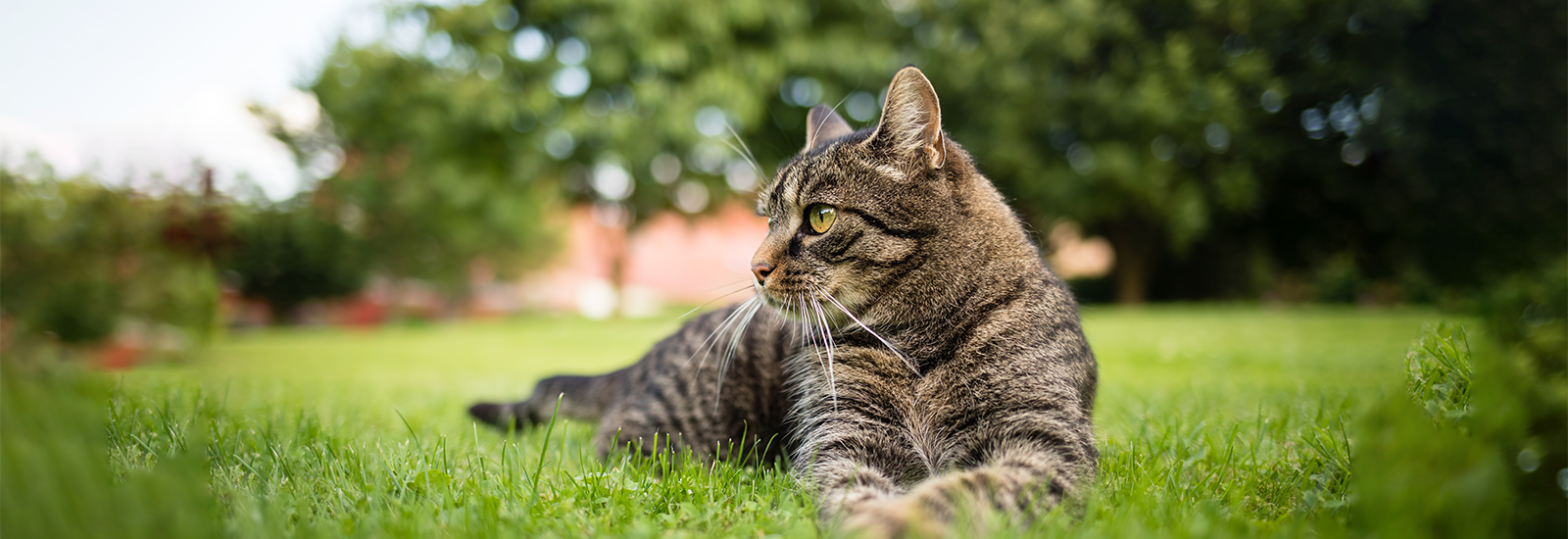European Shorthair
The European Shorthair is the pure breed of the normal domestic short-haired cat. The two often differ only slightly or not at all, which is why there is generally very little interest in this breed.
Profile of the European Shorthair
- Size medium
- Weight female: approx. 5 kg, male: approx. 6 kg
- Origin Europe
- Build robust, strong
- Length of fur short, dense
- Colour of fur all natural colours
- Grooming minimal
- Behaviour active, affectionate
- Character inquisitive, warm-hearted
Appearance and character of the European Shorthair
If you were to take five normal domestic short-haired cats and five purebred European Shorthairs and ask someone to tell them apart, this would prove to be an almost impossible task. This is because, unless one of the domestic cats happens to be a purebred of another breed, they will all have the same appearance as the cats that we are used to seeing walking around outside. And this can be extremely varied. Basically, almost all colours and patterns are possible. There are, however, exceptions. And this is precisely what the European Shorthair is all about.
It is important to preserve their enormous natural diversity in order to prevent the same thing happening as with the British Shorthair. These were also originally normal domestic cats. However, as a result of all kinds of cross-breeding, they underwent significant changes. In other countries, this has not yet happened, which is why in Germany, for example, there is an untouched natural population of European Shorthairs. They can have countless different colours, markings, patterns and spots. But the breed standard does not allow, for example, “points” (relatively darker extremities) or a particularly fluffy coat that would indicate crossbreeding with another breed. A wide range in size and weight is also permitted, and even two different eye colours are allowed. Anything that can occur naturally is fine.
In addition, there are often no differences in character between “normal” domestic shorthairs and purebred European Shorthairs. They are playful, inquisitive, active and affectionate, and love contact with their humans. With a European Shorthair you can expect this, but with a normal domestic short-haired cat it is not always the case. This can be explained by the fact that the European Shorthair will always grow up in the care of a family and is therefore familiar with close contact with humans right from the start. This is not the case with farmyard kittens, for example. These may well grow up in a barn and therefore tend to be very reserved towards people at first The risk of them being timid and preferring their freedom is much higher than with a European Shorthair.
Keeping and caring for a European Shorthair cat
If you want a domestic short-haired cat that likes people and has little interest in roaming around outside, a European Shorthair is the ideal choice for you. The only problem is that many animal shelters and private individuals do not distinguish between the terms “domestic short-haired cat” (also referred to as “Domestic Shorthair”, “House Cat” or simply “Shorthair”) and “European Shorthair”. You could be forgiven for thinking that there are countless types of pure-bred animals. However, this is not the case. Often, any cat that does not belong to another particular breed is simply referred to as a European Shorthair. In principle, this is often true, however the subtle difference regarding whether a cat is known to have grown up in human care and whether there are no undesirable colours and no possible interbreeding is often overlooked. Finding genuine European Shorthair breeders who can document the lineage of their cats can prove a real challenge in most countries. However, for anyone who does not intend to buy their cat from a breeder, this is of little importance. The only thing that matters will be whether the particular cat appeals to them in terms of its character and appearance.
Keeping a European Shorthair is usually very straightforward. It is a highly adaptable breed that would enjoy being allowed to go outside, but will also have no problem with being kept indoors if there are enough things to keep it occupied in its home and it has another cat to play with. The European Shorthair is perfect for families.
Caring for a European Shorthair is also easy. As with domestic short-haired cats, they do most of their grooming themselves. It is, however, important to regularly carry out a brief check. If you comb your cat once or twice a week, you will be able, for example, to detect any parasites or skin irritations at an early stage and be able to take appropriate measures. Your pet will also be happy if you give it a little help during the moulting period. This will prevent it from swallowing too much hair when it cleans itself.
Nutrition
Whether it’s a kitten, an adult cat or a senior – the food for a European Shorthair cat should always be of high quality and tailored to its age. Cats are carnivores by nature, so cat food should always contain a high proportion of meaty ingredients. Sugar, flavour enhancers and artificial colourings and preservatives do not belong in the food.
animonda has the ideal food for every stage of your cat’s life. You can choose between kitten, adult and senior cat food. The products are specially formulated to meet the specific nutritional requirements of the different life stages of cats. This provides the best foundation for your pet to enjoy a long and healthy life.
Health of the European Shorthair
European Shorthair cats do not tend to have any hereditary diseases. They are known to be very healthy and particularly robust. However, this does not mean that they cannot become ill. To minimise the risk, responsible breeders have all the recommended vaccinations carried out as well as any advisable genetic tests. This minimises the risk of illness, but it does not rule it out, which is why an annual health check should be carried out by a vet.
History and breeding
Domestic short-haired cats have been around for thousands of years. They were and still are welcome housemates on farms because they help to keep the mouse population down. The variety among them is almost unlimited, because nobody pays attention to who mates with whom. This is exactly what many people like. Almost every cat looks different and is a little bundle of surprises. It was exactly the same with the British Shorthair. However, breeders realised that the animals would sell better if they were fluffier and rounder in appearance and looked more like a cuddly toy. For this reason, Russian Blue and Persian cats were crossed with other breeds. As a result, today’s British Shorthairs bear little resemblance to normal domestic shorthairs.
In order to retain all the characteristics of the typical European domestic short-haired cat, breeders in various European countries joined forces in the 20th century and established a standard. There was great interest in officially recognising the breed, especially in Scandinavia, Denmark and the Czech Republic. This finally came about in 1982, when the European governing body, FIFé, adopted the breed in its statutes. Here, it is stated that: “it is assumed that the 'ideal' European cat is completely free of cross-breeding with other breeds and does not differ from the European domestic short-haired cat.”
The plan to establish a standard for domestic short-haired cats across Europe had basically succeeded. However, as many countries in Europe have a large population of domestic short-haired cats that thrive more or less without any particular intervention, there is often only limited interest in purebred European Shorthairs. In most territories, the European Shorthair has not yet been able to establish itself as a pedigree cat which means that it is extremely difficult to find breeders who can verify that they are purebred. However, as long as domestic short-haired cats in general continue to develop naturally, this is a situation that most people are happy to live with.
You may also like this

Feeding kittens - nutrition tips
What kittens need for healthy development

Good cat food
How to recognize good cat food for your darling

A kitten is moving in
Tips for colletcion, initial equipment and settling in

Getting your cat used to being outdoors
Hot to get your cat used to going outside

